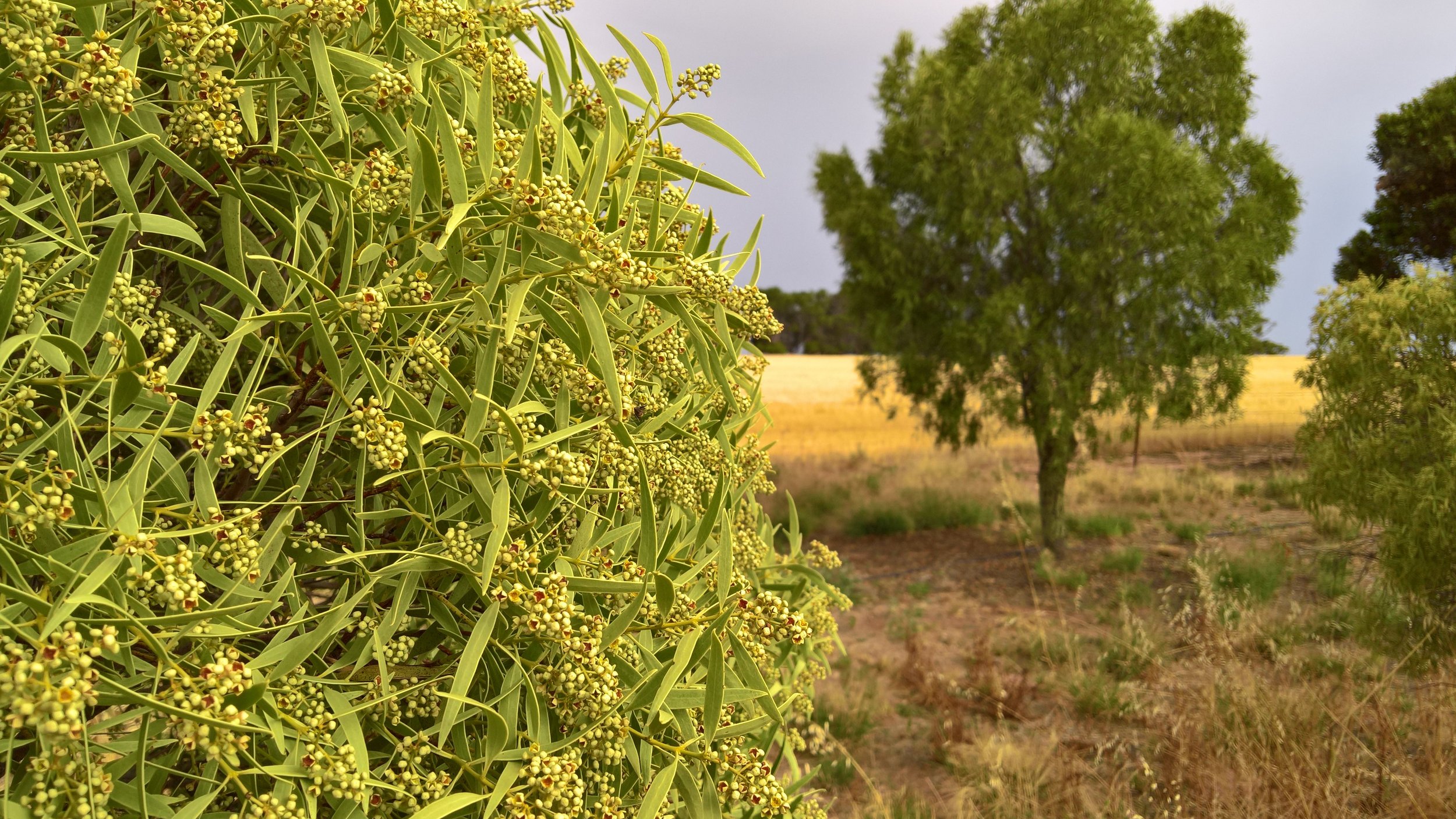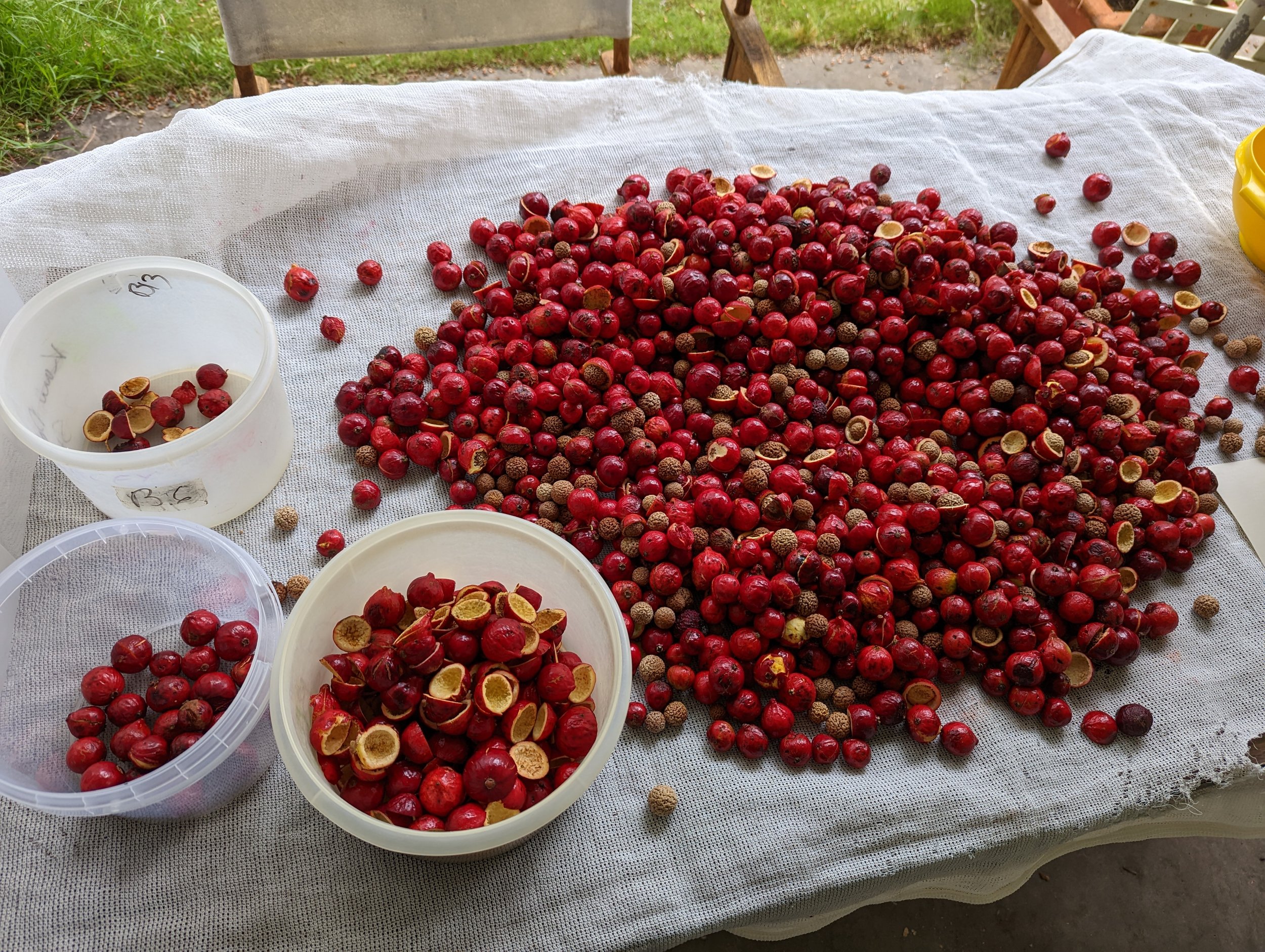Quandongs
Quandongs
Quandongs are small trees that grow in Australia’s arid and desert interior. The vibrant red fruit is tart, tangy, slightly sweet, and high in vitamin C.
Quandongs have been used to make jam since the 1800s. Today they are widely used by leading chefs in both savoury and sweet dishes.
Quandongs are parasitic trees, meaning they need to grow amongst a diverse vibrant community of other plants. This makes them especially suited for biodiverse revegetation projects. Our farm includes about 30 acres of naturally revegetated scrub that has made an excellent host for our quandongs.
Learn more about quandongs…
-
Fresh quandongs have a unique refreshing tangy flavour. When cooked, the skin’s red pigment becomes the dominant colour while the flavour becomes more subtle and broad.
Quandongs can be used in savoury and sweet dishes, adding depth to sauces and relishes, or paired with meats for a uniquely Australian twist.
Quandongs are packed with nutritional benefits, particularly high in vitamin C—making them an excellent addition to a balanced diet. They’re also rich in antioxidants, which support overall health and wellbeing. Low in fat and sugar, Quandongs offer a nutritious way to enjoy a sweet and tangy native fruit.
The late Jack Lockett, who passed away at 111 y.o. in 2002 was particularly fond of quandongs. Download the article from The Age newspaper to find out why.
-
Quandongs grow in Australia’s arid and semi-arid interior, south of the tropics and west of the Great Dividing Range all the way to the coast of Western Australia.
Quandongs are a member of the Santalum genus which includes the Australian sandalwood – one of Australia’s earliest exports. All santalums are parasitic plants. Their roots form attachments to the roots of other plants and draw moisture and nutrients from them. A quandong’s health, grow rate and the quality of their fruit is fully dependent on their ability to form strong attachments to a diversity of host plants, especially large trees.
At Ni-Ni-Well we choose to provide other natives as hosts. This allows us to derive an income from land that has been left to naturally revegetate. Some of our seed producing wattles also provide additional services as quandong hosts.
Given their vast natural range, quandongs were, and are used by many aboriginal groups.
The Wiradjuri people of New South Wales use the name guwandhang, from which the name quandong was adapted. Other indigenous names include wolgol (Noongar, Southwestern Australia) gutchu (Wotjobaluk, Western Victoria); wanjanu or mangata (Pitjantjatjara, Uluru), and goorti (Narungga). The large, pitted stone of the quandong was used as decoration and the oily kernel inside was used as a salve for cuts and grazes.
Quandong Gallery

This image shows a halved quandong with the stone nestled inside the flesh of the fruit.

This image shows how quandong trees are propagated. We take our best-on-ground genetic material and grow more quandong trees from them.

Shiny red quandongs close up in their ripened, just harvested state.

A very healthy flowering quandong tree. Quandongs flower in summer, just after harvest. A healthy summer flowering event like this is a good indication that we can expect lots of fruit from the next quandong harvest in November.

A ripe quandong ready for harvest.

Halved quandongs with their stones removed.

Lots of helping hands sorting quandongs after harvest.

Quandongs that have just been harvested. They are majestic looking with their shiny red skins.

Ripe quandongs, ready to harvest. Being red, they look like Christmas baubles. We harvest quandongs in October and November which heralds the Christmas season. They are ripe once the fruit has become detached from the stone, and you can feel it softly rattling inside.

Quandongs being lightly poached in a sugar syrup. This is an easy way to prepare quandongs for all sorts of cakes, pies, pavlovas and desserts.

Quandong stones removed from the fruity flesh. We think they resemble brains.

Quandongs being sorted and cleaned. We sort harvested quandongs into first grade and second grade.

